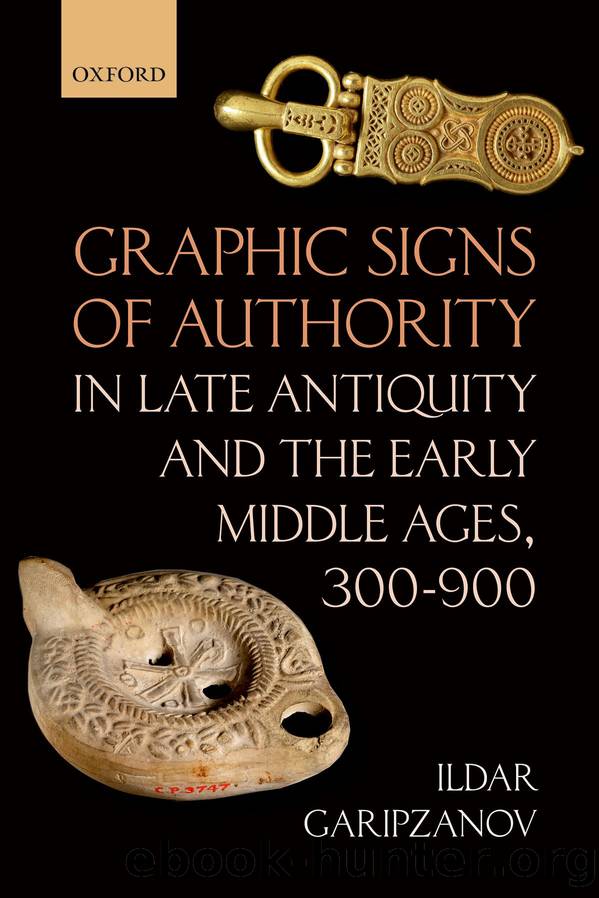Graphic Signs of Authority in Late Antiquity and the Early Middle Ages, 300-900 by Garipzanov Ildar;

Author:Garipzanov, Ildar; [Garipzanov, Ildar]
Language: eng
Format: epub
Publisher: Oxford University Press USA - OSO
Published: 2018-03-07T00:00:00+00:00
1 Based on textual evidence, Mango and Å evÄenko, âRemainsâ, date the construction of the church to c.524â7. But the brickstamp evidence suggests that the construction of the church took place in two stages starting after c.508/9 and ending before 528: Bardill, Brickstamps, vol. 1, pp. 62â4 and 111â16.
2 Jones, Martindale, and Morris, The Prosopography, vol. 2, pp. 143â4, 635â6, and 795â8.
3 The Oracle of Baalbek, ed. Alexander, p. 126, note 15.
4 Croke, âJustinian under Justinâ, pp. 16â19; Bjornlie, Politics, pp. 60â2.
5 Harrison, Excavations, vol. 1, pp. 4â5 and 419; Harrison, A Temple, p. 36.
6 Kiilerich, âThe Imageâ, with important corrections in Croke, âJustinian, Theodoraâ, p. 56, note 158; and Nathan, âThe Vienna Dioscoridesâ dedicatioâ, pp. 95â102.
7 Bardill, Brickstamps, vol. 1, pp. 62â4 and 111â16.
8 The Chronicle of Marcellinus, ed. Croke, p. 41; Croke, âJustinian under Justinâ, p. 37; Antony Eastmond, âConsular Diptychsâ, p. 762.
9 James, âMaking the Nameâ, esp. pp. 63â5.
10 Harrison, Excavations, vol. 1, p. 420.
11 Harrison, A Temple, p. 139; Harrison, Excavations, vol. 1, pp. 5â7. On the architectural similarities with the Solomonic Temple, see Bardill, âA New Templeâ.
12 Harrison, Excavations, vol. 1, p. 414; Harrison, A Temple, p. 80; and Strube, Polyeuktoskirche, pp. 61â80.
13 Canepa, The Two Eyes, pp. 210â16.
14 Mango and Å evÄenko, âRemainsâ, p. 240; Harrison, A Temple, pp. 90, 121, nos. 2aâb, figs 111â20; Deichmann, ed., Corpus, pp. 138â41, nos. 639â40; Eastmond, âMonogramsâ, pp. 219â20 and 226â7.
15 Harrison, Excavations, vol. 1, p. 130, nos. 6a iâii, figs 143, 144, and 154. See also a fragment of a pier with the monogram of St Polyeuktos within a box frame, Harrison, Excavations, vol. 1, p. 162, nο. 21, fig. 236.
16 A reused capital in the Papadopoli Gardens in Venice, identified as originally belonging to this church, has a badly preserved box monogram, which is also difficult to decipher: Vickers, âA âNewâ Capitalâ.
17 Bell, Social Conflict, p. 276.
18 On the rather deficient educational backgrounds of Justin I and Justinian I, see Croke, âJustinian under Justinâ, pp. 19â22.
19 Joachim Kramer suggests that the use of monumental monograms as signs of ruling sovereigns started at the end of the fifth century: âKämpferkapitelleâ, p. 189.
20 Dresken-Weiland, âEin Kämpfer-Kapitellâ.
21 For stylistic reasons, these capitals have been dated to the first half of the sixth century, Sodini, Barsanti, and Guidobaldi, âLa sculptureâ, p. 323.
22 Cirelli, Ravenna, pp. 98, 236, and 248.
23 Bloch, âThe Pagan Revivalâ, pp. 204â5.
24 Guidobaldi, âI capitelliâ; and Brandenburg, Die frühchristlichen Kirchen, p. 155, fig. 90.
25 Deichmann, Ravenna, vol. 2.2, pp. 206â30; Sodini, âMarquesâ, pp. 503â10; Sodini, âMarble and Stoneworkingâ, p. 134.
26 Roueché, Aphrodisias, VII.15â17, nos. 101â3 and plate xxvii.
27 Roueché, Aphrodisias, no. 101 and plate xxvii. The capitals with the monogram of Symbaticius belong to a type dated to the sixth century; see Sodini, âMarble Capitalsâ, p. 189.
28 Roueché, Aphrodisias, Introduction.10â12.
29 Mango, âThe Church of Saints Sergius and Bacchus at Constantinopleâ; Mango, âThe Church of Sts. Sergius and Bacchus Once Againâ.
30 Krautheimer, âAgain Saints Sergius and Bacchusâ; Mathews, âArchitectureâ; Bardill, âThe Churchâ. For a new argument in favour of a later date, namely between 532 and 536, see Bardill, âThe Date, Dedicationâ.
Download
This site does not store any files on its server. We only index and link to content provided by other sites. Please contact the content providers to delete copyright contents if any and email us, we'll remove relevant links or contents immediately.
| Africa | Americas |
| Arctic & Antarctica | Asia |
| Australia & Oceania | Europe |
| Middle East | Russia |
| United States | World |
| Ancient Civilizations | Military |
| Historical Study & Educational Resources |
The Daily Stoic by Holiday Ryan & Hanselman Stephen(2709)
The Fate of Rome: Climate, Disease, and the End of an Empire (The Princeton History of the Ancient World) by Kyle Harper(2436)
People of the Earth: An Introduction to World Prehistory by Dr. Brian Fagan & Nadia Durrani(2346)
Ancient Worlds by Michael Scott(2104)
Babylon's Ark by Lawrence Anthony(2070)
Foreign Devils on the Silk Road: The Search for the Lost Treasures of Central Asia by Peter Hopkirk(2056)
India's Ancient Past by R.S. Sharma(1988)
MOSES THE EGYPTIAN by Jan Assmann(1973)
The Complete Dead Sea Scrolls in English (7th Edition) (Penguin Classics) by Geza Vermes(1842)
Lost Technologies of Ancient Egypt by Christopher Dunn(1798)
The Daily Stoic by Ryan Holiday & Stephen Hanselman(1770)
The Earth Chronicles Handbook by Zecharia Sitchin(1744)
24 Hours in Ancient Rome by Philip Matyszak(1678)
Alexander the Great by Philip Freeman(1650)
Aztec by Gary Jennings(1545)
The Nine Waves of Creation by Carl Johan Calleman(1520)
Curse Tablets and Binding Spells from the Ancient World by Gager John G.;(1510)
Before Atlantis by Frank Joseph(1484)
Earthmare: The Lost Book of Wars by Cergat(1469)
